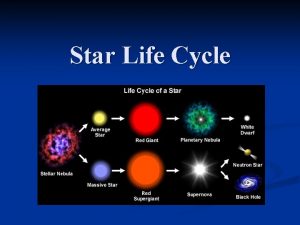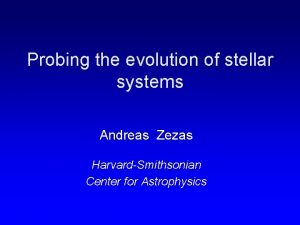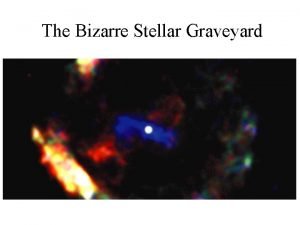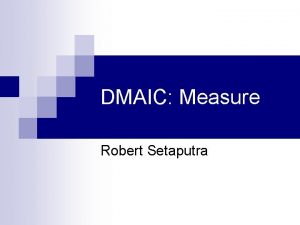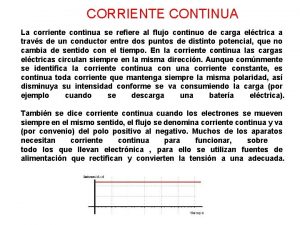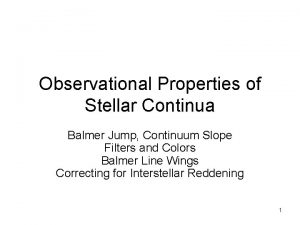Stellar Continua How do we measure stellar continua













- Slides: 13

Stellar Continua • • How do we measure stellar continua? How precisely can we measure them? What are the units? What can we learn from the continuum? – – Temperature Luminosity Metallicity Presence of binary companions • Bolometric corrections

Measuring Stellar Flux Distributions • • • Low resolution spectroscopy Wide spectra coverage Access to fainter stars Typically R~600 Use a large (but not too large) entrance aperture • Correct for sky brightness and telluric extinction

Primary Photometric Standards • Vega (A 0 V) • Compared to standard laboratory sources, usually black bodies • Flux measured in ergs cm-2 s-1 A-1 at the top of the Earth’s atmosphere • Often plotted as – – Fl vs. A Fn vs. wavenumber (cm-1 = 1/l in cm) Log Fl + constant vs. A Log Fn + constant vs. wavenumber

Calculating Fl from V • Best estimate for Fl at V=0 at 5556 A is Fl = 3. 54 x 10 -9 erg s-1 cm-2 A-1 Fl = 990 photon s-1 cm-2 A-1 Fl = 3. 54 x 10 -12 W m-2 A-1 • We can convert V magnitude to Fl: Log Fl = -0. 400 V – 8. 451 (erg s-1 cm-2 A-1) Log Fn = -0. 400 V – 19. 438 (erg s-1 cm-2 A-1) • With color correction for 5556 > 5480 A: Log Fl =-0. 400 V – 8. 451 – 0. 018(B-V) (erg s-1 cm-2 A-1)

Class Problems • Assuming an atmosphere + telescope + spectrograph+ detector efficiency of 10%, how many photons would be detected per Angstrom at 5480 A using a 1. 2 -m telescope to observe a star with V=12 (and B-V=1. 6) for one hour? • Using the CTIO 4 -m telescope, an astronomer obtained 100 photons per A at 5480 A in a one hour exposure. Again assuming an overall efficiency of 10%, what was the magnitude of the star if B-V=0?

Interpreting Stellar Flux Distributions I. The Paschen Continuum • The Paschen continuum slope (B-V) is a good temperature indicator • Varies smoothly with changing temperature • Slope is negative (blue is brighter) for hot stars and positive (visual is brighter) for cooler stars • B-V works as a temperature indicator from 3500 K to 9000 K (but depends on metallicity) • For hotter stars, neutral H and H- opacities diminish, continuum slope dominated by Planck function, and the Rayleigh-Jeans approximation gives little temperature discrimination

The Paschen Continuum vs. Temperature 50, 000 K 4000 K

Interpreting Stellar Flux Distributions II – The Balmer Jump • The Balmer Jump is a measure of the change in the continuum height at 3647 A due to hydrogen bound-free absorption • Measured using U-B photometry • Sensitive to temperature BUT ALSO • Sensitive to pressure or luminosity (at lower gravity, the Balmer jump is bigger – recall that kbf depends on ionization, and hence on Pe) • Works for 5000 < Teff < 10, 000 (where Hbf opacity is significant)

Flux Distributions at T=8000 Log g = 4. 5 Log g = 1. 5

Bolometric Flux • Bolometric flux (Fbol) is the integral of Fn over all wavelengths • Fbol is measured in erg cm-2 s-1 at the Earth • Luminosity includes the surface area (where R is the distance from the source at which Fbol is measured): • L is measured in units of erg s-1

Bolometric Corrections • Can’t always measure Fbol • Compute bolometric corrections (BC) to correct measured flux (usually in the V band) to the total flux • BC is usually defined in magnitude units: BC = m. V – mbol = Mv - Mbol

Bolometric Corrections

Class Problem • A binary system is comprised of an F 0 V star (B-V=0. 30) and a G 3 IV star (B-V=0. 72) of equal apparent magnitude. – Which star has the larger bolometric flux? – What is the difference between the stars in Mbol?






